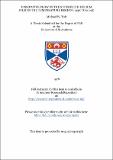Dissipative flow in the superfluid helium film in the temperature region 1.63K to 0.01K
Abstract
Experiments on helium film flow over a stainless steel beaker rim were carried out in the temperature region 1.63K to 11mK. No previous measurements have been made below 35mK. The results of other studies of film flow below 1K are mutually conflicting; this is thought to originate from poor temperature stability, inadequate vibration isolation and contamination of the substrate. Careful attention was paid to these points in the design and construction of a demagnetisation cryostat, full details of which are given. Flow experiments from initial level differences of ~8mm confirmed the existence of a range of metastable transfer rates at all temperatures. The variation of the mean rate with rim height suggests that the film profile should be calculated using a van der Waals' exponent, n, of 2.85 ± .25. The low temperature increase in transfer rate reported by others was observed, but did not extend below 1K. Instead, the mean transfer rate was approximately constant from 1K to 400mK, in direct conflict with the predictions of thermal fluctuation theories of superfluid dissipation. Below 250mK the results corroborated closely those of Crum et al in that the transfer rate fell sharply with decreasing temperature. Discrepancies arose between runs below 60mK, some showing the transfer rate to decrease monotonically with temperature down to 20mK whilst others indicated a levelling out of the transfer rate, followed by a slight increase at the lowest temperatures. These effects were thought to originate from changes in the concentration of the ³He impurity in the film. Steady state driven flow experiments at level differences of <500μm provided the first evidence for the existence of dissipation at subcritical transfer rates at temperatures below 1K. That is, superfluid flow was shown to be never strictly frictionless. Above 1K, the form of the subcritical dissipation curve conformed to the predictions of thermal fluctuation theories, but the values of the parameters 3 and f₀ for flow over stainless steel were considerably smaller than those reported for flow over glass. The parameter f₀ was also found to be strongly temperature dependent. Below 1K, the onset of dissipation was seen to be much more gradual, and the form of the subcritical dissipation curve was independent of temperature down to 20mK. These findings were corroborated by measurements of the damping of the inertial oscillations occurring at the end of each flow experiment. At the lowest temperature attained, 11mK, a change in subcritical dissipative behaviour was observed; exponential damping of the oscillations indicated that the frictional force on unit mass of superfluid was now directly proportional to the superfluid velocity, and was of magnitude (4.56 ± .28) x 10⁻³ dynes g⁻¹ cm ⁻¹ s. Exponential damping was also observed at temperatures above 1K, where Robinson type thermal dissipation was the dominant mechanism at small transfer rates.
Type
Thesis, PhD Doctor of Philosophy
Collections
Items in the St Andrews Research Repository are protected by copyright, with all rights reserved, unless otherwise indicated.

